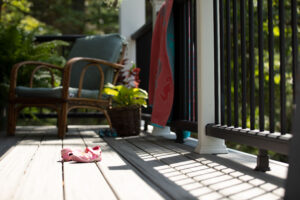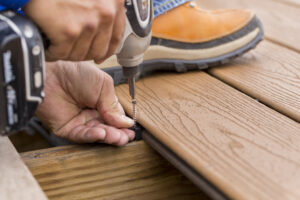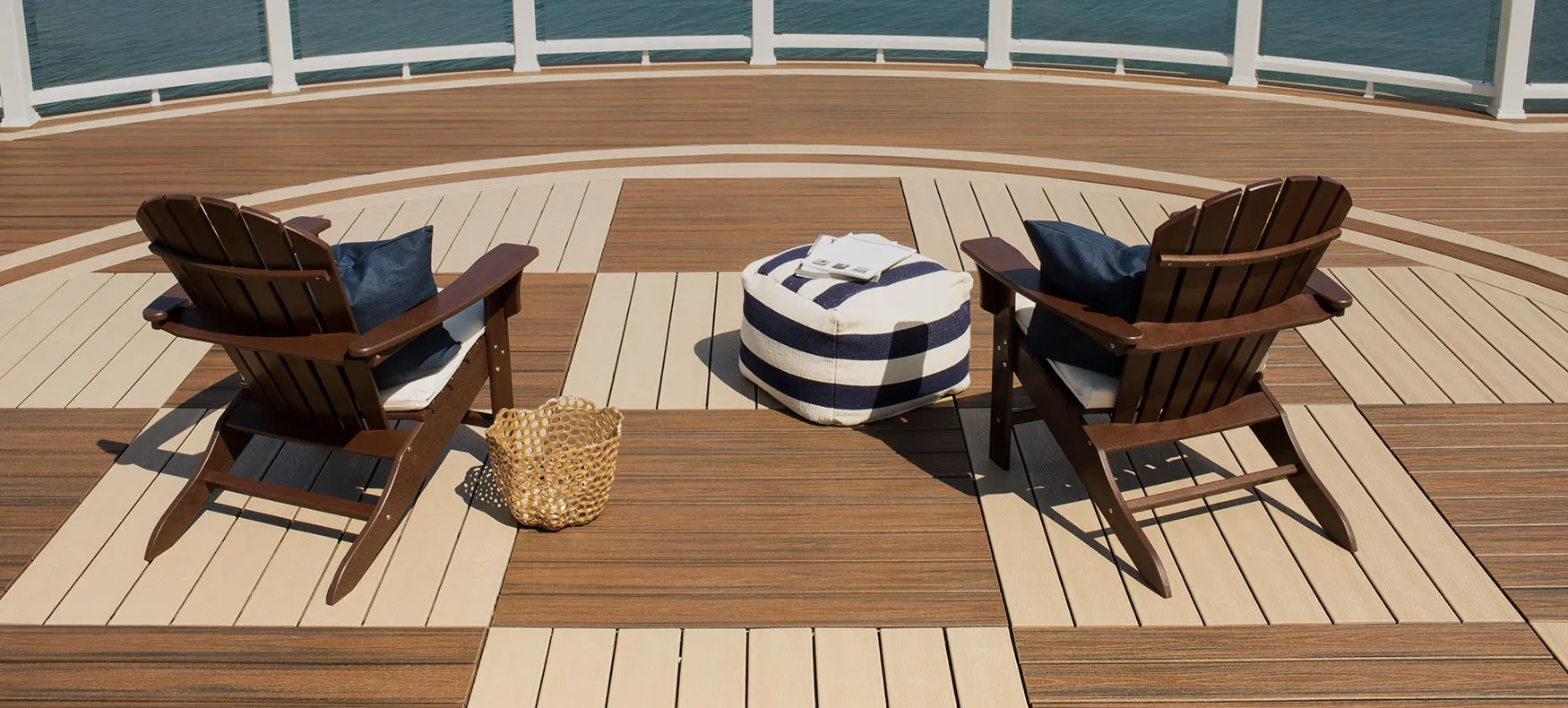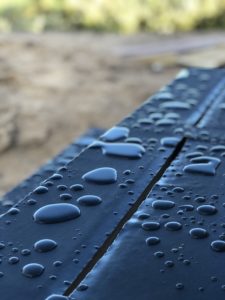What is Composite Decking?
By Dave Kile In my decades of building decks, I’ve learned that when it comes to outdoor living, the easier the living, the better. After all, who wants to spend their weekends maintaining their outdoor space when they could be enjoying it instead?
In my decades of building decks, I’ve learned that when it comes to outdoor living, the easier the living, the better. After all, who wants to spend their weekends maintaining their outdoor space when they could be enjoying it instead?
With its low-maintenance and long-lasting qualities, composite decking is experiencing significant popularity among homeowners who understand the advantages of building decks with composite decking over traditional wood. But what exactly is composite decking, and how does it compare to other decking materials such as wood, PVC, and aluminum?
What is Composite Decking?
Composite decking was invented in the late 1980s as the concept of sustainable living became more commonplace. Composites are a manufactured product made primarily from recycled materials and are designed to mimic wood while offering superior durability, worry-free maintenance, and enduring aesthetics.
What is Composite Decking Made Of?
While composite decking can be used to describe any decking board made from a blend of materials, the most common composite decking, called wood-plastic composite, is made from:
- Recycled plastic film (polyethylene or polypropylene)
- Wood fibers, often from sawdust or reclaimed wood
- Binding agents or resins (UV stabilizers, colorants, mold inhibitors)
These ingredients are blended and formed into boards through extrusion, a manufacturing process in which material is pushed through a tool to create a specific shape. Color and grain patterns are subsequently added, along with treatments to prevent rot, scratching, and staining. This produces a deck board that is similar in appearance to wood but far easier to maintain, more attractive, and longer-lasting. Plus, these composite boards often come with manufacturer performance warranties of up to 50 years.
Wood-Plastic Composite versus Mineral-Based Composite
A mineral-based composite board is made from a composite material that replaces traditional wood fibers with inorganic minerals, such as calcium carbonate or stone dust, and utilizes polypropylene or high-grade PVC instead of plastic film.
Mineral-based decking has many of the same durable benefits as wood-composite – it won’t rot, mold, or decay. It is lighter, stronger, and more resistant to moisture, heat, and scratching than wood-plastic composites and costs more per lineal foot.
Wood-Plastic Composite versus PVC Decking
PVC (polyvinyl chloride) decking is made from synthetic plastic, containing no organic material such as wood fiber. It offers much of the same durability as wood-plastic and mineral-based composites. It is lighter than its competitors and may hold up better in moisture-prone areas since it is made entirely of plastic. While it costs more, PVC decking can be less slip-resistant than its competitors and is not as environmentally friendly, as it contains additives that can pose environmental threats.
Wood-Plastic Composite versus Aluminum Decking
While not nearly as popular as other decking materials, aluminum decking has some advantages, primarily in fire-prone regions. Made entirely of aluminum and 100% recyclable, it offers many of the same benefits in terms of durability. Aluminum is lighter in weight than competitors, but costs significantly more (it’s often two to three times more expensive). It also lacks the natural look of wood and can produce a noisy, metallic sound when walked on.
Types of Composite Decking
Early-Generation versus Current-Generation
The differences between the earlier-generation and the current generation of composite decking are vast. The first wood-plastic composite boards were uncapped, meaning they were made with a durable composite core but lacked a protective outer layer. Boards were basic brown or grey, with no grain pattern, and were prone to staining, fading, scratching, mold, and mildew.
Around 2010, innovations by Trex addressed early drawbacks to uncapped decking, resulting in improved performance and aesthetics.
Today’s composite decking combines that same composite core with a moisture- and stain-resistant polymer shell that wraps around the core. This shell resists fading, staining, molding, and disintegrating. Some brands encapsulate all four sides of the board with the protective shell, while others cover just the top and sides of the board.
In addition to improved durability, today’s composite decking offers better aesthetics with beautiful, rich color options, including multi-tonal variegated designs, various grain patterns, and performance warranties ranging from 25 to 50 years.
Solid versus Hollow Boards
Composite decking boards are available in two styles: solid or hollow. Hollow can refer to either a board with hollow chambers running through the length of the board or to a board with a partially hollowed, scalloped bottom.
While both solid and hollow boards can be made from the same blend of recycled materials and perform well if installed correctly, they differ in construction.
Solid boards:
- Full profile provides a more natural look and feel of real wood
- Quieter underfoot, producing less echo when walked on
- Installation can be easier and quicker with no scallops or hollow tracks to cover up
- Typically costs more than hollow or scalloped boards due to more material
Hollow or Scalloped boards:
- Lighter weight can make them easier to carry, which can be especially important to a DIY installer or handy homeowner
- More affordable than solid boards
- Can feel less stable underfoot
- Hollow or scalloped ends may require more attention during installation to make them more aesthetically pleasing
Choosing between solid and hollow composite decking boards primarily depends upon your aesthetic choices and budget. Both offer the same low-maintenance appeal as well as beautiful color and grain variations. Hollow boards and scalloped boards are generally less expensive due to the use of less material and more limited warranties.
Hollow and scalloped boards can present more challenges during installation than solid boards. When installed correctly, both options perform well, but hollow boards may require more planning upfront if covering the ends of hollow chambers, or scallops, during the installation process is important to you.
Advantages of Composite Decking
While the upfront costs of composite decking are greater than those of wood, the long-term advantages are substantial. Here are some benefits of composite decking:
- Low maintenance: Wood decks require regular maintenance, such as sanding, staining, and sealing, which cost hundreds of dollars a year, as well as more labor. Composite decks require only a periodic soap and water cleanup, delivering an investment that pays off in just a few short years
- Long-lasting durability: Composite decking resists rotting, warping, splintering, and is resistant to insect damage, and comes with residential performance warranties ranging from 25 to 50 years
- Aesthetically pleasing: With a wide range of color options, from rich browns to on-trend greys and deep reds, and grain patterns that mimic wood, composite decking has come a long way since its inception more than 30 years ago, allowing for limitless design possibilities that complement any home style. Mix and match colors, create inlaid patterns, and integrate railing and lighting for unique designs with composite decking
- Affordability: With options in a variety of price points, composite decking can fit nearly every budget
- Safety features: With a splinter-free surface and hidden fasteners, composite decking allows for a smooth surface that is safe for children, pets, and bare feet. Innovations in heat resistance also keep the surface cooler
- Mother Nature: Composites weather rain, snow, and sun better than wood. They can be submerged under water for long periods, making them a better choice for docks and saltwater environments
- More eco-friendly: Wood-composite deck boards are made from recycled plastic film and reclaimed wood, making them a sustainably friendly choice
Disadvantages of Composite Decking
While ideal for homeowners who prefer a long-term investment with minimal upkeep, composite boards are initially more expensive than wood boards because of their engineered manufacturing process.
- Linear foot costs: Composites costs generally run $5-$13 per lineal foot, versus $2-$5 for pressure-treated lumber
- Fasteners: Hidden fasteners, clips and screws made specifically for composites will cost slightly more than wood nails and screws
- Installation: Labor costs are fairly similar, but could run higher due to unique composite install requirements and for aesthetic choices made by the homeowner
- Like all material used outdoors, composite deck boards will retain heat. To stay cooler, select lighter-colored decking or choose boards made with heat-mitigating technology such as Trex SunComfortable
Composite Decking vs. Other Decking Materials
Here is a detailed comparison table of common decking materials:
| Feature | Composite Decking | Pressure
Treated Wood |
Cedar / Redwood | PVC Decking | Aluminum Decking |
| Material | Wood fibers + recycled plastic, capped or uncapped | Softwood treated with preservatives | Naturally rot-resistant softwood | 100% plastic (polyvinyl chloride) | Powder-coated or anodized aluminum |
| Durability | Highly durable; resists rot, insects, and warping | Moderate; vulnerable to rot, insects, and warping | More durable than PT but still organic | Very durable; resistant to rot, mold, and mildew | Extremely durable; impervious to insects and decay |
| Maintenance | Low; occasional cleaning only | High; requires staining/sealing every 1–3 years | Moderate; sealing/staining helps longevity | Very low; hose off occasionally | Very low; rinse as needed |
| Aesthetics | Consistent, modern wood-look options | Natural wood grain fades over time | Rich natural look; ages to silver if untreated | Smooth, uniform appearance; some realistic finishes | Sleek, modern industrial look; fewer color choices |
| Lifespan | 25–50 years | 10–20 years | 20–30 years | 30–50 years | 40–60+ years |
| Cost | $$$ – Mid to high initial cost | $ – Lowest initial cost | $$ – Moderate to high cost | $$$ – Comparable to or slightly higher than composite | $$$$ – Highest upfront cost |
| Heat Retention | Moderate to high; varies by color and brand | Moderate | Moderate | High; can get hot in sun | Low; stays cool underfoot even in sun |
| Eco-Friendly | Yes; often made with recycled materials | Less; uses chemicals and often unsustainable wood | Better if sustainably harvested | Not eco-friendly; plastic-based | Moderate; recyclable but intensive to produce |
| Slip Resistance | Good; textured surfaces improve grip | Fair; can be slippery when wet | Fair to good depending on grain and finish | Fair to good; varies by brand | Excellent; often designed with non-slip text@liures |
Frequently Asked Questions on Composite Decking
How long does composite decking last?
Manufacturers of wood-composite decking offer performance warranties ranging from 25 to 50 years for residential decks. If installed correctly and maintained according to the manufacturer’s guidelines, composite decking will far outlast wood and require significantly less maintenance.
Is composite decking slippery when wet?
Because it is made of plastic or plastic film, composite decking can be slippery. Care should be taken when boards are wet from mildew, rain, dew, ice, and snow. Boards with deep wood grains or embossing can offer better grip. Some capped boards are engineered for better slip resistance.
Can composite decking be painted or stained?
No. Today’s generation of composite decking should never be painted or stained. Painting or staining will compromise the integrity of the nonporous polymer shell and will void the manufacturer’s warranty. Early-generation boards can be painted or stained. Consult the manufacturer’s care and cleaning guidelines for details.
How do you clean and maintain composite decking?
Shelled composite decking boards are easy to clean and maintain. A simple soap and water wash a few times a year should be sufficient to keep a deck looking like new. Power washing on a low setting can also be used. Let deck boards air dry to prevent slipping.
Does composite decking get hot in the sun?
Yes, composite decking can get hot in direct sunlight, especially in the summer or in warmer regions, like most materials used to create outdoor spaces. Light-colored boards tend to stay cooler, as do those manufactured with heat-mitigating technology.
Is composite decking eco-friendly?
Yes, composite decking is considered eco-friendly compared to traditional pressure-treated lumber and tropical hardwoods. The sustainable impact varies according to brand, materials used, and the manufacturing process. Trex, the leading manufacturer of wood-composite decking, makes boards that are up to 95% recycled by using plastic film and reclaimed wood fiber.
Conclusion
We were made for outdoor living. Spending time in nature has been scientifically proven to have health benefits. Extending your home into the outdoors with a deck that’s made to last can help you spend more time enjoying your yard.
Composite decking combines beauty, durability, and convenience. While it may cost more upfront, homeowners I’ve worked with over the years value the long-term savings in labor and maintenance.
Building decks with composite decking is a smart, eco-friendly investment that pays off quickly for many homeowners. And the aesthetic advantages can’t be beaten by wood. It’s never been easier to design and build the deck of your dreams.
